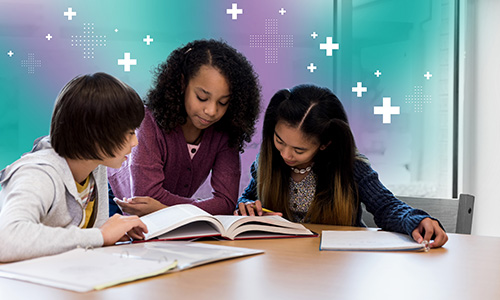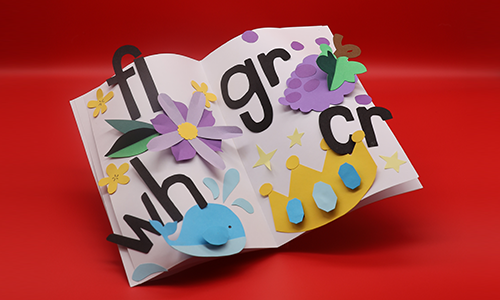
When was the last time you had to read something you couldn’t understand? Stumped? That’s probably because you’re an excellent reader. I’m an excellent reader, too, so I asked my sister if I could review an article she was writing in support of her doctoral dissertation. “Maybe I can give you some constructive feedback?” I said, confident that my ELA teaching experience would pay off. Text complexity isn’t something I often worry about.
Two paragraphs in, and I was lost. So I buckled down and reread a few key sentences: “Over the past 50 years, a picture has been developing of the brain’s unique waste removal system. […] Here, we review the relevant literature with a focus on transport processes, especially the potential role of diffusion and advective flows. […] Communication relies on molecular transport, where transport rates determine the range-of-action for neurotransmitters and transport effects cell-to-cell communication (Ray and Heys, 2019).”
Nope. Still clueless. Time to admit my own hubris. I just don’t have the background knowledge or the discipline-specific vocabulary in chemical engineering I need to understand an article titled, “Fluid flow and mass transport in brain tissue.”
The power of not understanding (from a teacher’s perspective)
Humbled as I was after attempting to read my sister’s article, it dawned on me that I have asked students to do a similar kind of reading, and I have expected better results.
The problem isn’t that students shouldn’t be reading complex, grade-level texts. In fact, they should be reading more of them, since we know students’ ability to comprehend complex texts is a key determiner of their college and career readiness. But learning from complex texts requires what literacy expert Tim Shanahan calls “accommodative and supportive instruction.” In essence, if we want students to grapple with complex texts, we need to plan for their success.
Here’s a simple three-step process for setting students up for success with complex texts.
1. Understand what makes a text complex
It’s common for many K–12 educational publishers and curriculum providers to report quantitative measures of text complexity, such as Lexile®. These measures can offer a good starting place for librarians, caregivers, and even students to explore and select reading materials. However, for classroom instruction, we need to dive deeper into the qualitative aspects of a text’s complexity because doing so can better reveal what supports our students might need to access a text.
There are four key qualitative dimensions to consider:
- Purpose (for informational texts) or levels of meaning (for literary texts). Purpose refers to why the author wrote an informational text, what it’s about, and its intended effect on the reader. Levels of meaning are the different ways a literary text can be interpreted, such as through themes or metaphors. A text may have a literal interpretation but also a deeper, more abstract meaning.
- Structure. Structure refers to how an author connects ideas, processes, and events in a text. This includes how the text is organized as a whole, as well as within specific paragraphs or larger sections of text. Structure also includes visual elements and text features, such as headings or sidebars.
- Language conventionality and clarity. Language conventionality refers to the vocabulary and sentence structures in a text, while language clarity refers to how dense or abstract the language is, as well as how challenging an author’s stylistic choices, such as voice, diction, and tone, are.
- Knowledge demands. Knowledge demands refer to the amount and type of knowledge (e.g., prior knowledge) a reader must bring to a text to access its full meaning. Types of knowledge can include general, common-practical, discipline-specific, culturally specific, and regionally specific knowledge.
2. Identify what makes a specific text complex
In my sister’s article, the language and knowledge demands added the greatest text complexity, so it’s no surprise my comprehension broke down in those areas.
On the other hand, her article’s purpose (to explain the brain’s unique waste removal system) and structure (a review of relevant literature) were fairly explicit. This explicit information provided a helpful scaffold when the going got tough, which was often with word- and sentence-level meanings. I didn’t know what “advective flows” were, for instance, but I did know from the article’s explicit purpose that they had a “potential role” in the brain’s “waste removal system.” And while I couldn’t fathom what the “range-of-action” for neurotransmitters might be, I could figure out from the syntax that these actions involved “cell-to-cell communication.”
In the end, I still had much to learn about “molecular transport,” since its “rates” and “effects” seemed very important to brain health. But overall, I was getting much closer to the main gist of the article, and I was living and breathing Tim Shanahan’s advice to focus on sentence-level comprehension.
3. Uncover the barriers students might face and plan accordingly
To anticipate potential barriers in text complexity for our students, we have to put ourselves in their shoes. When we compare students’ prior knowledge to what a reader is expected to bring to a text, we can better plan to address any potential gaps. A great way to start this analysis is with a list of questions developed for content-area read-alouds in K–8 classrooms.
In my case, the greatest barrier to understanding my sister’s article was my lack of exposure to technical terms like “transport processes” and scientific concepts like “diffusion.” Because I couldn’t tap into any prior knowledge, I couldn’t connect these ideas to new learning. But I did have other assets to leverage. I knew the general meaning of academic words, like “relies” and “transport,” even though I didn’t know their specific meanings in this context. Still, that vocabulary knowledge helped me. It revealed the relationship between ideas in the text—“Communication relies on molecular transport”—so I knew what questions to ask to better comprehend the text.
Students will have their own unique barriers to a text—but their own unique assets to leverage, too. To overcome barriers, try tapping into the funds of knowledge students bring with them to school, especially those from family, culture, and community. For example, medical and scientific texts like my sister’s article are often full of Latin-based vocabulary. Native Spanish speakers are often better than native English speakers at understanding Latin-based vocabulary because Latin and Spanish share so many cognates (words with similar spellings and meanings across languages).
If we can give our students clarity about why they are reading, and intentionally plan for their success, we can better prepare them for real-world complex texts they’re sure to encounter in whatever career they choose.
Keep in mind that language and knowledge demands are only half the equation for accessing complex texts. Students will also need support in determining the purpose or levels of meaning of a text and in navigating its structure. Repeated exposure to informational and literary texts in different genres gives students a strong foundation, as does repeated practice with articulating an author’s purpose and exploring the deeper meanings of a text, such as its themes and central ideas.
Explicitly teaching text structures is another method that has positive effects on reading comprehension, including among students who are learning English. Remember that informational text structures are more varied and often more complex than literary text structures. And since students typically have less exposure to informational texts in school, they can greatly benefit from more explicit instruction.
Do a little extra (planning) to address text complexity
Helping all students access the content and meaning of complex texts is the first and most critical step in planning, but there’s even more we can do to ensure all students succeed with complex texts. That’s because preparing students to tackle complex texts requires sparking their interest and motivation just as much as providing appropriate scaffolds to increase their access.
Aspire to meet the following three extra goals in future lesson plans.
Planning goal #1: Make it engaging!
For many students, the term “complex text” sounds dreadfully boring. But we can flip that dynamic on its head by incorporating movement and expression into our lessons. While engaging students in text analysis is the primary goal, we can also find ways to tap into their creative talents.
For example, students can tackle the language and structure demands of a text by working in small groups to memorize and perform an excerpt from the text, such as the prologue to Shakespeare’s Romeo and Juliet. This might begin with choral readings, so students can learn how unfamiliar words are pronounced, and then progress to adding more expression (prosody) and movement as students pick up the rhythm of the language, such as stomping or clapping to Shakespeare’s use of iambic pentameter.
Students will be more engaged when learning difficult vocabulary or navigating complex text organization if they know they’ll need the information to perform for other people. Questions like “What does the word ‘dignity’ mean in ‘Two households, both alike in dignity’?” or “What is the purpose of a prologue?” become more practical when students need the answers to create a strong performance. An added benefit of such explicit knowledge is that it provides a scaffold for students as they work through dense or difficult language in a text. My students often referred to the prologue of Romeo and Juliet, for instance, because it provides a concise summary of the play.
Planning goal #2: Make it accessible!
Letting students tell you what they know and don’t know about a topic is another authentic way to grapple with complex text, as I did when struggling with my sister’s article. Students of any age can create their own questions to investigate. Mine was, “What is molecular transport anyway?”
Students might explore a text’s levels of meaning in small groups, for example, and then present, discuss, and revise their findings with other small groups. While this process can be done with any text, poetry is an excellent choice, especially when students can make their own selection. If your class includes multilingual learners, you might offer (or help students find) poems originally written in a home language, such as Spanish or African American English. If possible, provide a side-by-side comparison of the original poem and its translation into general academic English. This will prompt students to think about the meanings of specific words and phrases, and it will encourage multilingual learners to leverage their linguistic and cultural knowledge to assess whether meanings have been altered or lost in translation.
Small group work is a great way to facilitate these discussions, and poetry also lends itself well to teaching students how to create and use text annotations.
Planning goal #3: Make it meaningful!
What do your students care about? What do their communities care about? What is important to this generation of young people? When we find ways to make complex texts more relevant to students’ lived experiences and the real world, we add that extra bit of purpose, meaning, and motivation everyone needs to persist through a difficult task, such as dealing with text complexity.
Consider that students might take a daunting issue, like climate change, and work in small groups to investigate various aspects of it. Strive for tasks that require students to sort through misinformation and disinformation as they develop their own position on a topic. This will force them to consider the purpose of the texts they read, especially when conducting research.
Research projects also help students think about the knowledge demands of the texts they write: Who is my intended audience? What do they already know about this subject? What knowledge outside the text do they need to bring to the text to understand my position? If the goal of the research project is to influence one’s peers, students may need to find or develop primers on unfamiliar concepts so their texts can convince classmates rather than confuse them. Finally, you might culminate this research task with a student-led summit fashioned after a real-world event. This requires a little extra work and planning, but it’s a powerful way to show students how their ability to navigate complex texts prepares them for global citizenship.
The power of understanding (from a reader’s perspective)
When I attended my sister’s dissertation defense over Zoom, I was thrilled to see the many features she included that made her presentation more accessible for the lay person (aka, me!). There were detailed diagrams, friendly definitions, and an impressive animation that finally revealed to me how molecular transport happens in the brain. While I still didn’t understand everything, I understood a lot more than I did from reading the article alone. Most importantly, I understood the significance of my sister’s work in her field, which (to be honest) was a more realistic purpose for reading her article in the first place.
If we can give our students clarity about why they are reading—and intentionally plan for their success—we can better prepare them for real-world text complexity they’re sure to encounter in whatever career they choose, whether it’s in education, like me, or engineering, like my sister.




